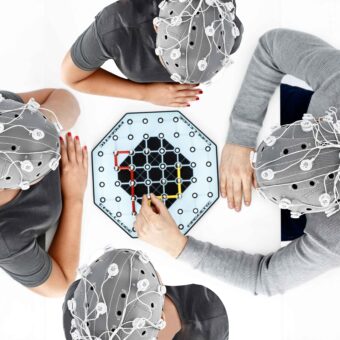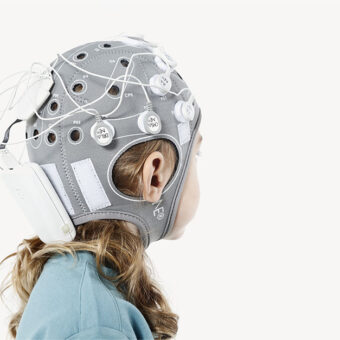While heading to Petronas Technology University where I will give a course on transcranial current stimulation (tCS) basics I summarized the basics of the technology and particularly on Starstim, the device we envisioned and started to develop within the HIVE project. tCS devices allow the controlled injection of low-amplitude electrical currents into the cerebral cortex through the electrodes, which are non-invasively placed on the scalp. In this sense they play the opposite role to EEG, i.e. not for monitoring brain activity but for modifying it. There has been some advancement in the tCS field, but the technology and its effects on the brain are still not fully understood. Well, the effects are showing up more and more as studies and clinical trials increase. As a matter of fact, publications on tCS have multiplied by a factor of 4 in the last 4 years, and the clinical trials involving it, even by a factor of 10. But what is still not really understood is what causes this effect from both an electrophysiological as well as therapeutic point of view. I would like to comment on the electrophysiological effects giving some quick hints on what makes the applied electrical current affect the brain activity at the neuronal level. The state of the art is far from this understanding on its effects at neuronal population level and at a global brain level, i.e. connectivity, which have been much less studied.
Different types of tCS
As you may know if you have been following this blog, the different types of tCS are classified upon the type of injected electrical current. While the injection of direct current (DC), i.e. whose amplitude is constant over the application time interval, is denoted as tDCS, the use of alternating current (AC), which presents an amplitude that varies over time with a periodic pattern, receives the acronym tACS. By a large margin tDCS is the one most studied and therefore the only one with clear therapeutic applications so far. Different pain-related pathologies, e.g. migraine, fibromyalgia, and stroke derivatives can be effectively treated with tDCS. Some other evidences show the potential of the technique for treating major depression and enhancing particular cognitive functions. Besides tDCS and tACS the last type of tCS is denoted as transcranial random noise stimulation (tRNS). In this case we apply a noisy current signal to the scalp, i.e. whose amplitude randomly changes over time. From all of them this is the one still only used in research studies.
What makes tDCS work?

Let us start with the application of DC current and its study at neuronal level. While the electrical current goes through the scalp and cortex it encounters different mediums. Each time it goes through the limit between two mediums it leaves some charge behind. This is what happens when traversing the neuronal membrane, which constitutes the interface between the interior of the neuron and its environment. These charges generate a voltage difference, which makes the resting potential of the membrane either decrease or increase, depending on its sign, i.e. on the current sense. Therefore the neuron is correspondingly either more likely or less likely to fire. When applying an anodal current, the action potential thresholds of pyramidal cells under the anode application area are lowered, meaning that they fire more easily. Therefore this current, and its associated electrical field, is considered excitatory. On the other hand a cathodal current would present an inhibitory effect.
Nitsche and Paulus showed in the year 2000 that an anodal current applied over the motor cortex was able to increase the amplitude of a TMS-evoked motor potential in human subjects, whereas a cathodal one, was able to decrease it. However, this clear role of anodal vs cathodal does not match last year’s findings and it seems to be more complex than previously thought. The inhibitory nature of cathodal tDCS only applies for current intensities lower than 2 mA and applied for less than 20 minutes as shown also by Nitsche and colleagues. It is worth mentioning that it is not clear what makes the difference above these 2 limits. In that paper the research group in Göttingen showed that our knowledge on the technique has still some dark zones and plenty of room for new surprises even for the most studied modality of tCS.
What about tACS and tRNS
The lack of understanding is worse in the case of tACS and tRNS. In the first case there have been some works starting from the point that AC current behaves anodal in its positive cycles and cathodal in its negative ones. This is for instance reflected by Frhölich and colleagues in a recent work. This seems to have its effect at the neuronal network level. The injection of AC current makes a neuronal population basically resonate at the stimulation frequency. This amplifies the amplitude of a particular natural brain rhythm after the stimulation ends. In this context a work by Zaehle and colleagues that appeared some years ago clearly showed an example of this type of effect while using the frequency of the alpha peak. Hence tACS would play the role of amplifying natural rhythms. Given the relationship between these and the cognitive functions of the human brain, this may seem to have a clear practical translation but still a long way to go.
Few experimental works have been presented in the literature that use tRNS. So there is a lack of confirmed protocols and of their expected outcomes. Since a random noise signal is an electrical signal with a flat spectrum, i.e. which presents all frequencies simultaneously, we can think of tRNS as an AC stimulation at several frequencies. My personal view on tRNS is that this is a type of stimulation with an exploratory value. If you do not know which natural rhythm characterize a particular cognitive process or task, you could stimulate with random noise in order to hit that rhythm for sure. Again this is a very limited view and for sure the tCS future will deliver new unexpected results.




